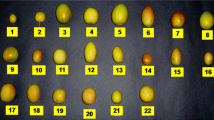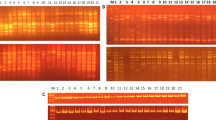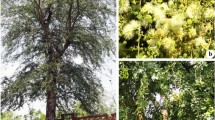Abstract
Mungbean germplasm characterization, evaluation and improvement are fundamentally based on morpho-agronomic traits. The lack of break-through in mungbean production has been due to non-availability of genetic variability for high yield potential. Forty-four genotypes of mungbean [Vigna radiata (L.)Wilczek] were subjected to random amplified polymorphic DNA (RAPD) analysis to assess the genetic diversity and relationships among the genotypes. Multilocus genotyping by twelve RAPD primers generated 166 markers and detected an average of intraspecific variation amounting to 82% polymorphism in banding patterns. Dendrogram obtained from cluster analysis delineated all the 44 genotypes into six clusters. Higher values of Nei’s gene diversity (h) and Shannon information index (i) and genetic distance analysis validate existence of wide genetic diversity among mungbean genotypes tested. Besides internal transcribed spacer (ITS) length variations, single nucleotide polymorphisms (SNPs) and insertions/deletions (INDELS) were detected at number of sites in nuclear rDNA region and the sequences of representatives of each sub-cluster and all distinct genotypes have been submitted to NCBI database and assigned Gen accession numbers HQ 148136-148147. Multiple sequence alignment revealed further lineages of distinct genotypes with main RAPD clusters. The measures of relative genetic distances among the genotypes of mungbean did not completely correlate the geographical places of their development. The homogeneous phenotypic markers proved insufficient in exhibiting genetic divergence among mungbean genotypes studied. RMG-62, RMG-976, and NDM-56 have been identified as potential source of parents for crop improvement. RAPD primers, OPA-9 and OPA-2 as polymorphic genetic markers and number of pods/plant and number of seeds/plant as dependable phenotypic markers have been identified for improving yield potentials. This genetic diversity will be of significance in developing intraspecific crosses in mungbean crop improvement programme.





Similar content being viewed by others
References
De Candolle A (1886) Origin of cultivated plants. Hafner Publishing, New York
Vavilov NI (1926) The origin, variation, immunity and breeding of cultivated plants (translated by K Starr, Chester). Chronica Bot 13:1–6
Zukovskij PM (1962) Cultivated plants and their wild relatives. Commonwealth Agriculture Bureau, London
Jain HK (1994) Pulses—the wonder plants of world agriculture. In: Ali M, Asthana AN, Mehta SL (eds) Twenty five years of pulses research in India. Indian Institute of Pulses Research, Kanpur, pp 1–4
Bisht IS, Mahajan RK, Kawalkar TG (1998) Diversity in green gram [Vigna radiata (L.) Wilczek] germplasm collections and its potential use in crop improvement. Ann Appl Biol 132:301–312
Manivannan N, Murugan E, Viswanathan PL, Dhankodi CV (1998) Genetic divergence in green gram. Legume Res 21:131–133
Smith JSC, Smith OS (1989) The description and assessment of distances between inbred lines of Maize-the utility of morphological, biochemical and genetic descriptors and a scheme for testing of distinctiveness between inbred lines. Maydica 34:151–161
Ramanujam S (1981) Biometrical basis for yield improvement in mungbean. In: Cowell R (ed) Proceedings 1st international mungbean symposium, AVRDC, Shanhua, p 210
Fatokun CA, Danesh D, Young ND, Stewart EL (1993) Molecular taxonomic relationships in the genus Vigna based on RFLP analysis. Theor Appl Genet 86:97–104
Kaga A, Tamooka N, Egawa Y, Hosaka K, Kamijima O (1996) Species relationships in subgenus Ceratotropis (genus Vigna) as revealed by RAPD analysis. Euphytica 88:17–24
Ehlers JD, Hall AE (1997) Cowpea (Vigna unguiculata L. Walp.). Field Crop Res 53:187–204
Tosti N, Negri V (2002) Efficiency of three PCR based markers in assessing genetic variation among cowpea (Vigna unguiculata spp. unguiculata) landraces. Genome 45:268–275
Bisht IS, Bhat KV, Lakhanpaul S, Latha M, Jayan PK, Biswas BK, Singh AK (2005) Diversity and genetic resources of wild Vigna species in India. Genet Resour Crop Evol 52:53–68
Ruangsuttapha S, Eimert K, Schroder MB, Silayoi B, Denduangboripant J, Kanchanapoom K (2007) Molecular phylogeny of banana cultivars from Thailand based on HAT-RAPD markers. Genet Resour Crop Evol. doi:10.1007/s10722-006-9169-2
Pathak R, Singh SK, Singh M, Henry A (2010) Molecular assessment of genetic diversity in cluster bean (Cyamopsis tetragonoloba) genotypes. J Genet 89:243–246
Williams JGK, Kubelik AR, Livak KJ, Rafalski JA, Tingey SV (1990) DNA polymorphisms amplified by arbitrary primers are useful as genetic markers. Nucl Acids Res 18:6231–6235
Esselman EJ, Crawford D, Brauner S, Stussy IF, Anderson GJ, Silva MO (2000) RAPD marker diversity within and divergence among species of Dendroseris (Asteraceae: Lactuaceae). Am J Bot 87:591–596
Li YC, Fahima T, Krugman T, Beiles A, Röder MS, Korol AB, Nevo E (2000) Parallel microgeographic patterns of genetic diversity and divergence revealed by allozyme, RAPD, and microsatellites in Triticum dicoccoides at Ammiad, Israel. Conserv Genet 1:191–207
Yu Z, Li QL, Huan L, Jie B, Man YY, Chen M, Ying FC, Xiao LQ, Fang C (2002) RAPD markers in diversity detection and variety identification of Tibetan hulless barley. Pol Mol Biol 20:369–377
Ghosh KK, Haque ME, Parvin S, Akhter F, Rahim MM (2009) Genetic diversity analysis in brassica varieties through RAPD markers. Bangladesh J Agric Res 34(3):493–503
Thomas G, Mohapatra T, Rao AR, Sharma RP (2006) Distinguishing Indian commercial wheat varieties using RAPD based DNA fingerprints. Indian J Biotechnol 5:200–206
Malviya N, Yadav D (2010) RAPD Analysis among Pigeon pea [Cajanus cajan (L.) Mill sp.] Cultivars for their Genetic Diversity. Genet Eng Biotechnol J 2010:1–9
Talebi R, Fayaz F, Mardi M, Pirsyedi SM, Naji AM (2008) Genetic relationships among chickpea (Cicer arietinum) elite lines based on RAPD and agronomic markers. Int J Agric Biol 10:301–305
Lakhanpaul S, Chadha S, Bhat KV, Chadha S (2000) Random amplified polymorphic DNA analysis in Indian mungbean [Vigna radiata (L.) Wilczek] cultivars. Genetica 109:227–234
Afzal MA, Haque MM, Shanmugasundaram S (2004) Random amplified polymorphic DNA (RAPD) analysis of selected mungbean [Vigna radiata (L) Wilczek] cultivars. Asian J Pol Sci 3(1):20–24
Saini A, Reddy SK, Jawali N (2004) Evaluation of long primers for AP-PCR analysis of mungbean genetic relationships and fingerprinting of some genotypes. Indian J Biotechnol 3(4):511–518
Chattopadhyay K, Ali MN, Sarkar HK, Mandal N, Bhattacharyya S (2005) Diversity analysis by RAPD and ISSR markers among the selected mungbean [Vigna radiata (L.) Wilczek] genotypes. Indian J Genet Pol Breed 65(3):173–175
Lavanya GR, Srivastava J, Ranade SA (2008) Molecular assessment of genetic diversity in mungbean germplasm. J Genet 87(1):65–74
Tantasawat P, Trongchuen J, Prajongjai T, Thongpae T, Petkhum C, Seehalak W, Machikowa T (2010) Variety identification and genetic relationships of mungbean and black gram in Thailand based on morphological characters and ISSR analysis. Afr J Biotechnol 9(27):4452–4464
Alvarez I, Wendel JF (2003) Ribosomal ITS sequences and plant phylogenetic inference. Mol Phylogenet Evol 29:435–455
Singh SK, Tiwari M, Kamal S, Yadav MC (2005) Morel phylogeny and diagnostics based on restriction fragment length polymorphism analysis of ITS region of 5.8S ribosomal DNA. J Biochem Biotechnol 14:179–183
Vogler DR, Bruns TD (1998) Phylogenetic relationships among the pine stem rust fungi (Cronartium and Peridermium spp.). Mycologia 90:244–257
Kakani RK, Singh SK, Pancholy A, Meena RS, Pathak R, Raturi A (2011) Assessment of genetic diversity in Trigonella foenum-graecum based on nuclear ribosomal DNA, internal transcribed spacer and RAPD analysis. Pol Mol Bio Rep 29:315–323
Hershkovitz MA, Zimmer EA, Hahn WJ (1999) Ribosomal DNA sequences and angiosperm systematics. In: Hollingsworth PM, Bateman RM, Gornall RJ (eds) Molecular systematics and plant evolution. Taylor and Francis, London, pp 268–326
Saini A, Reddy SK, Jawali N (2008) Intra individual and intra species heterogeneity in nuclear rDNA ITS region of Vigna species from subgenus Ceratotropis. Genet Res 90:299–316
Baldwin BG, Sanderson MJ, Porter JM, Wojciechowski MF, Campbell CS, Donoghue MJ (1995) The ITS region of nuclear ribosomal DNA: a valuable source of evidence on angiosperm phylogeny. Ann Mo Bot Gard 82:247–277
Jorgenson RD, Cluster PD (1988) Modes and tempos in the evolution of nuclear ribosomal DNA: New characters of evolutionary studies and new markers for genetic and population studies. Ann Mo Bot Gard 75:1238–1247
Mir BA, Koul S, Kumar A, Koul MK, Soodan AS, Raina SN (2010) Intraspecific variation in the internal transcribed spacer (ITS) regions of rDNA in Withania somnifera (Linn.) Dunal. Indian J Biotechnol 9:325–328
Carvalho A, Guedes-Pinto H, Lima BJ (2009) Genetic diversity among old Portuguese bread wheat cultivars and botanical varieties evaluated by ITS rDNA PCR-RFLP markers. J Genet 88(3):363–367
Andrew M, Kohn Linda M (2009) Single nucleotide polymorphism based diagnostic system for crop-associated Sclerotinia species. Appl Environ Microbiol 75:5600–5606
Xiao LQ, Möller M, Zhu H (2010) High nrDNA ITS polymorphism in the ancient extant seed plant cycas: incomplete concerted evolution and the origin of pseudogenes. Mol Phylogenet Evol 55:168–177
Birren B, Lai E (1993) Pulsed field gel electrophoresis: a practical guide. Academic Press, San Diego, p 253
Sambrook J, Fritsch EF, Maniatis T (1989) Molecular cloning: a laboratory manual, 2nd edn. Cold Spring Harbor Laboratory Press, Plainview
White TJ, Bruns SL, Taylor J (1990) Amplification and direct sequencing of fungal ribosomal RNA genes for phylogenetics. In: Innis MA, Geltand DH, Sninsky TT, White TJ (eds) PCR protocols: a guide to methods and applications, Academic press, San Diego, p 315
Rohlf FJ (1997) NTSYS pc: Numerical taxonomy and multivariate analysis system version 2.02 h. Exeter Software, New York
Sneath PHA, Sokal RR (1973) Numerical taxonomy. W. H. Freeman, San Francisco
Peakall R, Smouse PE (2006) GENALEX 6: genetic analysis in excel. Population software for teaching and research. Mol Ecol Notes 6:288–295
Lewontin RC (1972) The apportionment of human diversity. Evol Biol 6:391–398
Nei M (1973) Analysis of gene diversity in subdivided populations. Proc Natl Acad Sci USA 70:3321–3323
Page RDM (1996) Tree View: an application to display phylogenetic on personal computers. Comp Appl Biol Sci 12:357–358
Martins SR, Vences FJ, Saenz de Miera LE, Barrosa MR, Carnide V (2006) RAPD analysis of genetic diversity among and within Portuguese landraces of common white bean (Phaseolus vulgaris L.). Sci Hortic 108:133–142
Gaffor AS, Ahmed AZ, Zahid MA, Rabbani MA (2001) Genetic diversity in black gram [Vigna mungo (L.) Hepper]. Field Crop Res 69:183–190
Bhat KV, Lakhanpaul S, Chadha S (2004) Amplified fragment length polymorphism (AFLP) analysis of genetic diversity in Indian mungbean [Vigna radiata (L.) Wilczek] cultivars. Indian J Biotechnol 4:56–64
Souframanien J, Gopalakrishnan T (2004) A comparative analysis of genetic diversity in black gram genotypes using RAPD and ISSR markers. Theor Appl Genet 109:1687–1693
Andreev IO, Spiridonova KV, Solovyan VT, Kunakh VA (2005) Variability of ribosomal RNA genes in Rauwolfia species: parallelism between tissue culture-induced rearrangements and interspecies polymorphism. Cell Biol Int 29(1):21–27
Saini A, Reddy SK, Jawali N (2008) Intra-individual and intra-species heterogeneity in nuclear rDNA ITS region of Vigna species from subgenus Ceratotropis. Genet Res 90(4):299–316
Barkley NA, Wang ML, Gillaspie AG, Dean RE, Pederson GA, Jenkins TM (2008) Discovering and verifying DNA polymorphisms in a mungbean [V. radiata (L.) R Wilczek] collection by EcoTILLING and sequencing. BMC Res Notes 1:28
Acknowledgments
The authors are thankful to Dr. M. M. Roy, Director, Central Arid Zone Research Institute, Jodhpur for providing necessary laboratory and field facilities and CSIR for providing financial assistance to carry out this study.
Author information
Authors and Affiliations
Corresponding author
Rights and permissions
About this article
Cite this article
Raturi, A., Singh, S.K., Sharma, V. et al. Molecular characterization of Vigna radiata (L.) Wilczek genotypes based on nuclear ribosomal DNA and RAPD polymorphism. Mol Biol Rep 39, 2455–2465 (2012). https://doi.org/10.1007/s11033-011-0996-7
Received:
Accepted:
Published:
Issue Date:
DOI: https://doi.org/10.1007/s11033-011-0996-7




